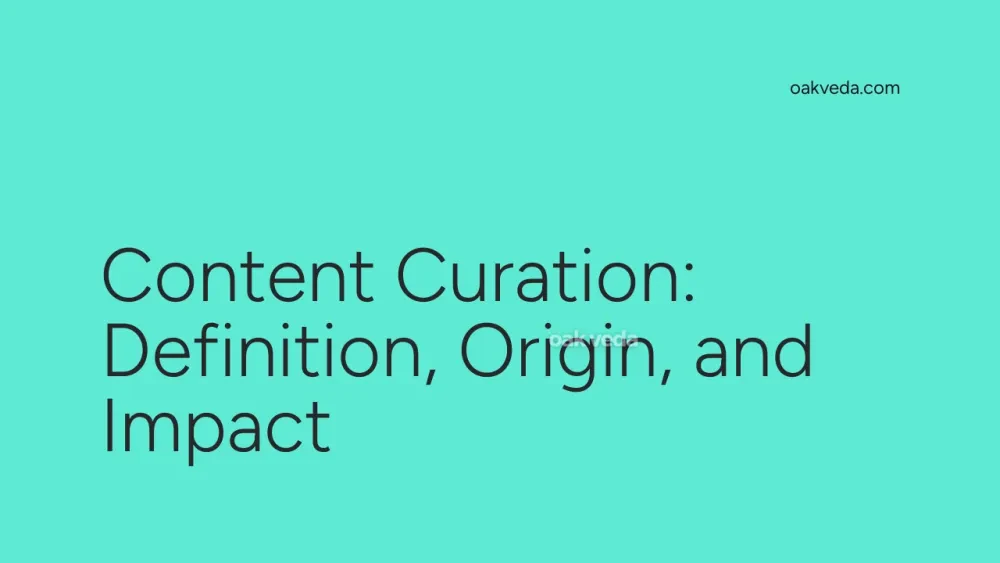
What is Content Curation?
Content curation is the strategic process of discovering, collecting, and presenting relevant digital content from various sources to a specific audience. It involves carefully selecting high-quality information, organizing it coherently, and sharing it through various platforms such as social media, blogs, or newsletters. Content curators act as filters, sifting through the vast sea of online information to deliver valuable, topic-specific content to their followers.
Origin and Development of Content Curation
While the term "content curation" gained popularity with the rise of social media, the concept has roots in traditional media and library science. Historically, newspaper editors, librarians, and museum curators have long been practicing forms of content curation. The digital age, however, democratized this process, allowing anyone with internet access to become a curator.
The emergence of social bookmarking sites like Delicious in the early 2000s marked the beginning of digital content curation. As social media platforms evolved, particularly with the launch of Twitter in 2006 and the rise of Facebook, content curation became an integral part of online communication and marketing strategies.
How Content Curation Works
Content curation typically follows these steps:
- Discovery: Curators use various tools and methods to find relevant content, including RSS feeds, social media monitoring, and manual searches.
- Selection: They evaluate content based on quality, relevance, and potential interest to their audience.
- Organization: Selected content is categorized and structured in a meaningful way.
- Contextualization: Curators add value by providing insights, summaries, or commentary on the curated content.
- Sharing: The curated content is distributed through chosen platforms, such as social media, newsletters, or blogs.
Types of Content Curation
Content curation can take various forms, including:
- Aggregation: Collecting and presenting content from multiple sources on a specific topic.
- Distillation: Curating the most relevant or highest quality content from a larger pool.
- Elevation: Identifying broader trends or insights from a collection of content pieces.
- Mashups: Merging different content pieces to create a new perspective or narrative.
- Chronology: Organizing historical content to show the evolution of a topic or trend.
Popular Examples of Content Curation
- Brain Pickings: Maria Popova's website curates content across various disciplines, offering insightful commentary on literature, science, and philosophy.
- The Skimm: A daily newsletter that curates and summarizes news stories for a millennial audience.
- Product Hunt: A platform that curates new and trending tech products and tools.
- Flipboard: A mobile app that allows users to create personalized magazines by curating content from various sources.
- Spotify Playlists: Curated music collections that showcase songs based on themes, moods, or genres.
Impact of Content Curation on Social Media Culture
Content curation has significantly influenced social media culture in several ways:
- Information Overload Management: It helps users navigate the overwhelming amount of content available online.
- Thought Leadership: Effective curation can establish individuals or brands as authorities in their niches.
- Community Building: Sharing curated content fosters engagement and builds communities around specific interests.
- Content Discovery: It exposes audiences to diverse perspectives and sources they might not have found otherwise.
- Algorithmic Influence: Social media algorithms often favor accounts that consistently share high-quality, curated content.
How Brands and Influencers Use Content Curation
Brands and influencers leverage content curation to:
- Provide value to their audience without constantly creating original content
- Demonstrate industry knowledge and stay relevant in their niche
- Increase engagement and foster relationships with followers
- Collaborate with other content creators and brands
- Supplement their content marketing strategy cost-effectively
For example, a tech company might curate and share the latest industry news, while a fashion influencer could curate outfit inspiration from various sources.
Future Trends Related to Content Curation
As content curation continues to evolve, several trends are emerging:
- AI-powered curation: Machine learning algorithms are becoming more sophisticated in identifying and recommending relevant content.
- Personalization: Curated content will become increasingly tailored to individual user preferences and behaviors.
- Interactive curation: Platforms may offer more ways for audiences to participate in the curation process.
- Video curation: With the rise of short-form video content, curating video clips is likely to become more prevalent.
- Niche curation: Ultra-specific content curation for highly targeted audiences will gain importance.
FAQs about Content Curation
Q: Is content curation the same as content creation? A: No, content curation involves selecting and sharing existing content, while content creation is the process of producing original content.
Q: How can I ensure I'm curating content ethically? A: Always give credit to original sources, add your own insights, and avoid copying entire pieces of content without permission.
Q: What are some popular content curation tools? A: Some popular tools include Feedly, Pocket, Scoop.it, and Flipboard. Social media management platforms like Hootsuite and Buffer also offer curation features.
Q: How often should I share curated content? A: The frequency depends on your audience and platform, but a general rule is to maintain a balance between curated and original content, such as a 60/40 or 70/30 ratio.
Q: Can content curation improve SEO? A: Yes, when done properly. Curating high-quality, relevant content can increase engagement, build authority, and create opportunities for backlinks, all of which can positively impact SEO.
Content curation has become an essential skill in the digital age, helping both creators and consumers navigate the vast landscape of online information. As the internet continues to expand, the role of content curators in filtering, organizing, and contextualizing information will only grow in importance.
You may be interested in:
- Cross-Posting: Definition, Origin, and Impact on Social Media
- Bet: Definition, Origin, and Impact on Social Media
- Cheugy: Definition, Origin, and Impact on Social Media
- Finsta: Definition, Origin, and Impact on Social Media
- Influencer Marketing Software: Definition, Origin, and Impact
- Pinned: Definition, Origin, and Impact on Social Media

